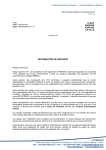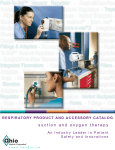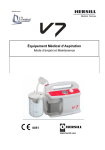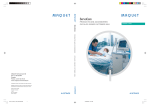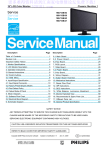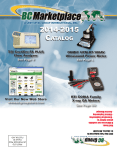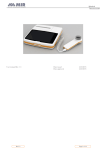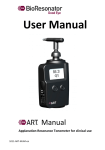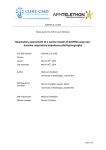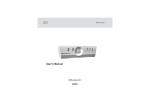Download USER MANUAL FOR CO2 ABSORBER CIRCUIT
Transcript
USER MANUAL FOR CO2 ABSORBER CIRCUIT KAV-1 Puerto de Navacerrada 3, P.I. Las Nieves 28935 Móstoles - España Tlfo.: 91 616 4642 - Fax: 91 616 4892 Manual Ref.: 9130001 Edition: 2002 Revision: 3 0318 KAV-1 INSTRUCTION MANUAL CO2 absorber INTRODUCTION The circular circuit is a respiration system that contains one-way inspiration and expiration circuits, together with a CO2 absorbing device. COMPONENTS OF A CIRCULAR SYSTEM The basic components of a circular system are: - A common fresh gas intake. - One inspiratory branch and one expiratory branch, each one equipped with a one-way valve. - A spontaneous / manual ventilation circuit, including a reservoir bag. - A mechanical ventilation circuit, including a concertina or bellows. - A CO2 absorption system (canister). - An APL or overpressure valve for manual ventilation, a pressure-limiting valve for mechanical ventilation and a residual gas exhaust conduit. HERSILL KAV-I ABSORBER DEVICE The new KAV-1 CO2 absorber is made of stainless steel, brass, polysulfone and silicon, making it the ideal choice for: - Surgery in the operating theatres of hospitals and public health clinics. - Veterinary and dental surgery. - Emergencies, ambulances and military uses. All the device’s components have been designed and manufactured to optimise its use. For example, the apparatus has a smaller-than-usual canister because experience has shown that large tanks of soda lime are harder to handle. The CO2 absorption capacity can easily be doubled or trebled by placing one canister on top of another. The circuit can be used both for high and low flow techniques: 1. High flows: Using fresh gas flows near the patient’s normal ventilation. In this case the circular system behaves as a partial reinhalation/non-reinhalation system, increasing the effective life of the soda lime with higher fresh gas flows. 2. Low flows (1 - 1.5 l/min) or minimum flows (0.5 - 1 l/min) of fresh gases for the patient’s ventilation. Using this circular circuit with low flows permits the following: a) b) c) d) e) f) g) h) High use of fresh gases; Minimum possibilities of leaks; Efficient use of the soda lime; Minimum risk of disconnection; Only the inhaled gas passes through the soda lime; It improves heat and humidity retention; Economic benefit, reducing the annual costs of volatile anaesthetic agents; Reduction in amount of nitrous oxide (N2O) released to the atmosphere, where it causes a greenhouse effect, and of other inhalatory agents. To change the nature of the circuit from reinhalation to non-reinhalation, or vice-versa, you only have to change the flow of fresh gases, and there are no switches. When the circuit is adapted to our REX and REGINA anaesthesia machines, and to our ORBI portable anaesthesia device, with all the monitoring devices, it can be used for the following purposes: a.- For monitoring of essential ventilation parameters. b.- For extensive monitoring of respiratory gases. It can be also used with the following devices: c.- A respirator with an ascending concertina. d.- A vaporiser suitable for operating with low flows. e.- High-precision variable area flowmeters equipped with an antihipoxia system. The appropriate position of the expiratory valve in the system, and the carefully studied position of the fresh gas supply, make the KAV-1 the IDEAL CIRCUIT FOR USE WITH LOW FLOWS INSTRUCTIONS FOR USE 1. Respiratory Circuit. Visually inspect all the components. Check that the inspiratory and expiratory valves work properly. Replace any faulty parts. For instructions on how to assemble the circuit, please turn to the annexes: - Assembly of the absorber circuit - Basic option - Assembly of the absorber circuit - Basic option + expirometer + manometer 2. Canister Check the state of use of the soda lime. Please note the absorbent change date, because an absorbent that has remained in a canister too long and become unusable may not have changed colour, without having reversed. Calculate the duration of the operation in relation to the state of the absorbent and its location (inspiratory or expiratory branch) so that it does not have to be changed while the patient is being anaesthetised. Before each operation, pass flows of 100% O2 through the lime deposit to remove any residual gases that may have accumulated during previous operations. Disconnect the canister from the circuit before filling it with soda lime. Pour the soda lime granules into the canister, turning it to ensure it fills smoothly (without pressing it). Put the canister back in the circuit. PRECAUTIONS - The canister must only be used in the upright position. - It must not be used near inflammable anaesthesia. - The accumulated condensation at the bottom of the canister is caustic, so be very careful and make sure that it does touch your skin when draining you are draining the canister. - If the ventilator is not connected, keep the manual/automatic switch in the manual position to avoid gas leaks. - A lack of absorbent may cause inefficient CO2 absorption, whereas an excess may cause inefficient sealing. - Make sure to check to respirator (see equipment manual) before you use the circular circuit and the canister. - After cleaning the circuit, check that the inspiratory and expiratory valves work properly. If they do not, make sure that they are dried and fitted correctly. - Make sure that the fresh gas intake tube is not crushed or folded, because otherwise an anaesthetic accident may occur. - DO NOT use vacuum system connected directly to the APL valve; place a collector system with a positive and negative pressure control in between the vacuum system and APL valve. LEAKS 1. Patient’s Circuit In order to detect leaks in the patient’s circuit, connect the fresh gas outlet to the outlet of the patient’s circuit. Select manual ventilation and close the APL valve. Close the variable air flowmeters. Block the circuit terminal (patient connector). Press the emergency O2 button until a pressure of + 30 cm H2O has been reached, and check that the circuit pressure manometer does not drop below this value. If no air circuit pressure manometer has been installed, leave the bag where it is and fill it to the top. Shut off the gas and check that the bag takes more than one minute to deflate. 2. Apl Valve and Exhaust Valve After performing the previous checks, and with the patient connector still blocked, open the APL valve gently and check that the gas escapes freely into the atmosphere. Apply the maximum flow and check that the pressure is below 5 cm H2O. Close the APL valve tightly. Keep the patient and bag connections blocked. Press the emergency O2 button and check that the pressure rises to 60 cm H2O. Replace the bag. 3. Inspiration and Expiration Valves Disconnect the patient’s circuit. Close the APL valve. Block the inspiratory valve outlet and Inflate the bag with a flow of approximately 2 l/min. Shut off the gas and check that the bag does not empty through the expiratory valve. Place another bag at the inspiratory valve outlet. Apply approximately 2 l/min of O2 to fill it. Shut off the gas. Check that the gas does not move flow back inside when you press the additional bag gently. Remove the additional bag and reinstall the circuit. Open the APL valve. 4. Manual/Automatic Selector Turn the selector to the “manual” position. Install a test bag on the Y-shaped connector. Close the APL valve. Inflate the system with 2 l/min. Move the selector to the “automatic” position and check that the system empties through the ventilator connection gate. Select manual. Reinstall the system, checking the bags inflate and open the APL valve to check that the system empties through it. CLEANING AND DESINFECTION. Any parts that are removed from the circuit (except for the pressure manometer and Expirometer) must be cleaned in soapy water before being decontaminated or sterilised. The parts must be sterilised for 30-45 minutes at 120º-130º in an autoclave. 1. Canister These components MUST be cleaned. The soda lime tends to stick to surfaces when it has been used. To ensure the canister is sealed properly, brush the seals and canister under running water to remove all the soda lime particles, whenever you change the lime. To drain off the humidity, connect the tube to the drain outlet and put the other end in an appropriate recipient. N.B.: The accumulated condensation at the bottom of the canister is caustic. Make sure that it does touch your skin. The canister must be dried thoroughly after it has been drained. 2. Inspiration / Expiration Valves Open the valves and rinse the disks and tops with water. Dry them very carefully. The disks MUST NOT be bent, because otherwise the system will not pass the operating tests. The pressure manometer and expirometer must be sterilised in ethylene oxide. ORDER REFERENCE NUMBERS CODE 5130000 DESCRIPTION CO2 ABSORBER Basic components: 4130001 4130002 5130010 0150013 0170004 0140115 CODE 4130003 0120005 3190300 0530003 5115500 Expiratory valve Inspiratory valve Canister APL valve Gas connector 1 metre anaesthesia tube OPTIONAL DESCRIPTION Manual / Automatic Selector Wright MK-8 Expirometer -20 to 100 cmH2O pressure manometer MINIOX III O2 monitor Patient’s circuit Components: 0170001 0170002 0140113 0170007 0170005 0142004 0170006 014000x 0140101 Male tube mount Female tube mount 22 mm 106 cm ringed tube Y-shaped connector Intubation connector 2 litre reinspiration bag Mask connector Anaesthesia mask 14 mm 9 cm fine ringed tube (3 units) ANNEXES ASSEMBLY OF THE ABSORBER CIRCUIT Basic Option Basic Option + Expirometer + Manometer LOW FLOW ANESTHESIA Circular Circuit Final Expiration Inspiration HIGH FLOW ANESTHESIA CIRCULAR CIRCUIT Final Expiration Inspiration












